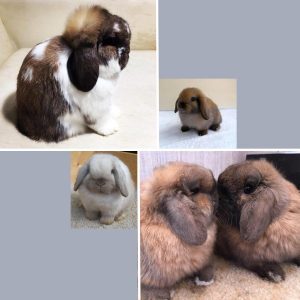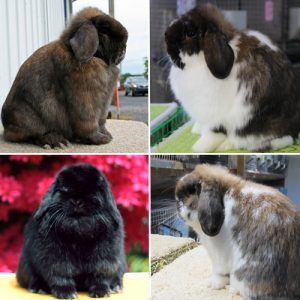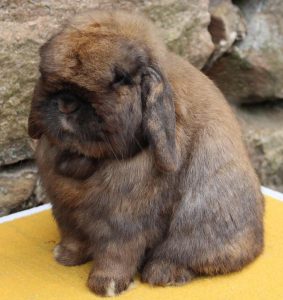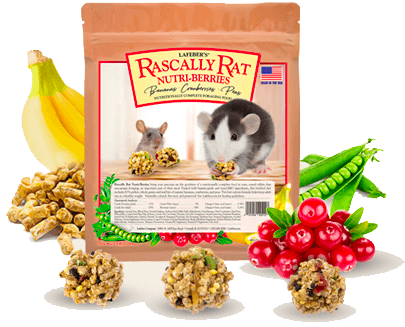
In a rabbit popularity contest, the Holland Lop currently hits the top 10, maybe the top 5, and is No. 1 for many people. The Holland Lop was developed in Holland and over the course of more than a decade. The breeds that contributed to the look of the Holland Lop include the Netherland Dwarf and French Lop. If colors are your thing, the Holland Lop is available in a wide array. This friendly little rabbit wins fans because of adorable looks and personality.
Colors: Holland Lops are categorized into eight color groups for showing, with more than 30 recognized colors overall.
Year Recognized By ARBA: 1979 (first official showing in 1980)
• In Holland and in countries guided by the British Rabbit Council, the breed is called the Miniature Lop.
• Holland Lops are nicknamed “The Hallmark Breed.”
• Holland Lops have rollback fur, meaning it gradually returns to normal position when stroked from back to front.
• Holland Lop Rabbit Specialty Club
Related Breeds
French Lop
Netherland Dwarf
Description

Holland Lops dial up the cuteness factor to high. Small and lop-eared, looking at them usually makes people’s hearts melt. It’s one of the most popular breeds in the United States.
The Holland Lop weighs no more than 4 pounds and has average length, rollback fur, and the distinctive lop ears. The standard of perfection for the breed calls for Holland Lops to have a compact body type that is short, massive, and thickset. It also specifies the ideal for the head, ears, fur, and other characteristics.
Colors

Part of the charm of the Holland Lop is the variety of colors available in the breed. Numerous colors are available across several groups.
Self Group: Black, Blue, Chocolate, Lilac, Ruby-Eyed White, Blue-Eyed White
Agouti Group: Chestnut, Chocolate, Chinchilla, Chocolate Chinchilla, Lynx, Opal, Squirrel
Broken: Any color with white
Pointed White: Black, Blue, Chocolate, Lilac
Shaded: Sable Point, Seal, Tortoise (black, blue, chocolate, or lilac), Siamese Sable, Smoke Pearl
Tan: Otter (black, blue, chocolate, lilac)
Ticked: Gold-Tipped or Silver-Tipped Steels in Black, Chocolate, Blue, or Lilac
Wide Band: Cream, Fawn, Frosty, Orange, Red, Tricolors
History
 According to the brief history on the website of the Holland Lop Rabbit Specialty Club and the book “Domestic Rabbits And Their Histories” by Bob Whitman, this breed took more than a decade to develop. Adrian de Cock, a rabbit breeder in Holland, began the process in 1949. The origin breeds included mainly French Lops and Netherland Dwarfs, with one English Lop in the mix. The Holland Lop breed was recognized by the national rabbit club in the Netherlands in 1964. The breed arrived in the United States in the mid-1970s. It was recognized by the American Rabbit Breeders Association at the 1979 convention in Tucson, Arizona, and shown for the first time as an official ARBA breed at the 1980 convention. Since then, it has grown to be one of the most popular rabbit breeds.
According to the brief history on the website of the Holland Lop Rabbit Specialty Club and the book “Domestic Rabbits And Their Histories” by Bob Whitman, this breed took more than a decade to develop. Adrian de Cock, a rabbit breeder in Holland, began the process in 1949. The origin breeds included mainly French Lops and Netherland Dwarfs, with one English Lop in the mix. The Holland Lop breed was recognized by the national rabbit club in the Netherlands in 1964. The breed arrived in the United States in the mid-1970s. It was recognized by the American Rabbit Breeders Association at the 1979 convention in Tucson, Arizona, and shown for the first time as an official ARBA breed at the 1980 convention. Since then, it has grown to be one of the most popular rabbit breeds.
Personality

Individual rabbit personalities vary, but the majority of Holland Lops do share some personality traits. Holland Lops as a breed are friendly, and male Holland Lops might be friendlier than females.
“The Holland Lop Rabbit is an easygoing and easy-to-handle rabbit,” says Stacy Hyatt, zone 6 director of the Holland Lop Rabbit Specialty Club. “Bucks are very outgoing and love to be pets. Does are a little shyer and can go through a nippy stage when they want to be bred, but this passes with age. They are very sweet, just not quite as animated as the bucks.”
Dyan Murphy of Murphy’s Lops in central Pennsylvania also remarked on the male personality.
“I personally have some boys that will come when called and will circle around my feet and put their feet up on me looking for attention,” she says.
Care

Holland Lop rabbits require the same care as most pet rabbits. This means offering proper diet, housing, and companionship. Rabbits mainly eat hay; it’s the bulk of their diet. Some rabbit-specific pellets add necessary vitamins and minerals. You can also offer vegetables and limited quantities of fruit, plus some healthy treats.
“The most important aspects to caring for your rabbit is to make sure they have UNLIMITED fresh water and as much hay as they would want to eat,” Hyatt says. “Hay keeps the digestive tract regular and productive. A good-quality pellet is necessary for nutrition, but hay and water are essential.”
Murphy says that Holland Lops are good pets for adults and for children 9 years and older. She recommends that anyone considering owning Holland Lops watch the rabbits for any signs of illness and also interact with the rabbits daily.
“An owner who has the time to devote to them and to interact with them on a regular basis is preferred over an owner who plans to put them in a cage and then ignore them,” Murphy says. “Most thrive on social interaction with their owners.”
Rabbits are social animals, so it’s best to adopt them in pairs or groups. If you share your life with rabbits, expect to interact with them daily for several hours. Out-of-cage time is special for bonding and also for letting your rabbits kick up their heels and enjoy themselves.
Handling rabbits takes extreme care. Rabbits have delicate skin that can tear and fragile bones. Most rabbits don’t enjoy being held, and petting is usually only permitted by people the rabbit trusts. It’s also true that some rabbits might not ever allow petting because they’re not comfortable with it.
“Like most rabbits, they generally do not feel safe when being held unless they are held correctly,” Murphy says. “Unfortunately, they are a smaller breed and easier to injure than some of the larger breeds.”
Health
“Hollands are susceptible to the same ailments as other breeds of rabbits,” Murphy says. “Having owned some other breeds, I think they may have a bit more sensitive digestive system than some other larger breeds.”
Murphy adds that some of the common rabbit ailments she watches for include enteritis in baby rabbits under 8 weeks of age, gut stasis, and bloat.
Hyatt considers Holland Lops a hardy breed.
“They very rarely suffer from ailments,” Hyatt says. “All rabbits can be affected by ear mites or fur mites from lack of husbandry, management, and cleanliness.”
Murphy recommends grooming Holland Lops during molting to minimize the amount of fur they ingest when they clean themselves. This can prevent fur blockage in the digestive tract. She also cautions against bathing rabbits, which can cause undo stress. Spot cleaning can be done as needed, but she warns never to submerge rabbits.
How do you know if your rabbit has an internal medical problem? Consulting with your veterinarian is always the best option, and your rabbit might give you some clues.
“I generally tell owners that what goes in must come out,” Murphy says. “If the rabbit isn’t eating or drinking, there is an issue. If the rabbit is not pooping, there is an issue. If the poop is not formed, there is an issue. We need to be always looking for signs of problems as they will hide their illness from us.”
As a further test, Murphy gives her rabbits a special treat each day. If they don’t eat it right away, she knows something might be wrong.
On The Internet
As with all things, you can find plenty of videos and photos about Holland Lop rabbits on the Internet. Are these Holland Lops celebrities? You be the judge.
PuiPui from Tokyo is on Instagram and also on Facebook





